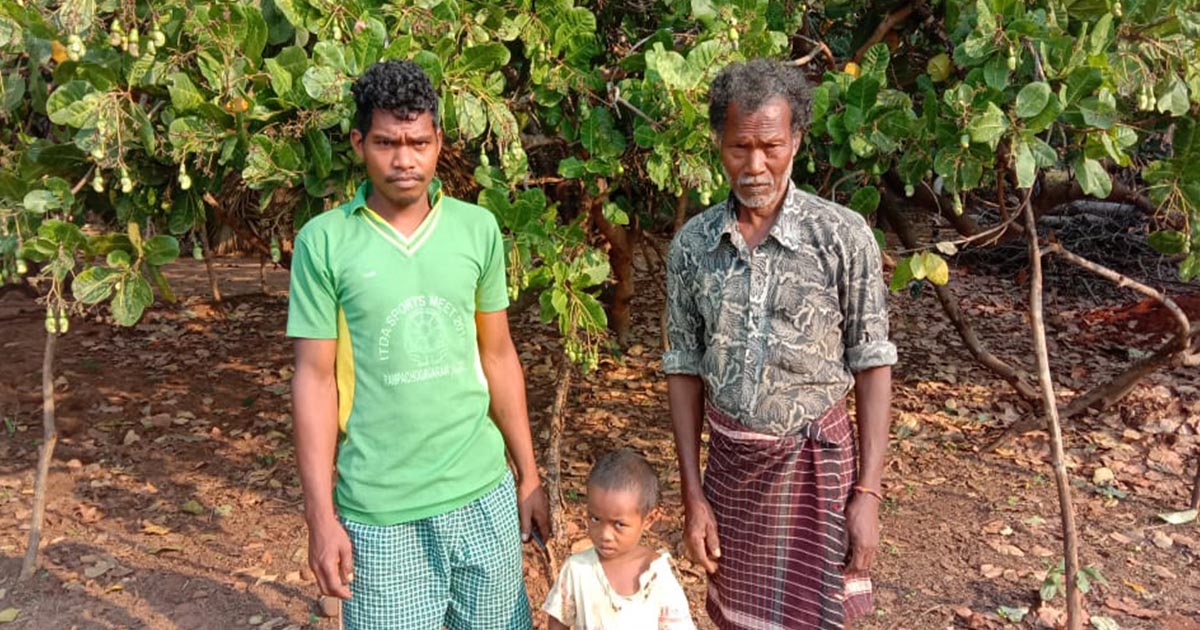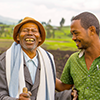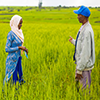The COVID-19 pandemic has had a significant impact on the agricultural extension system, but digital technology has helped us minimize its effects on our outreach among farmers and extension agents. As in the case of our pilot project, funded by the Walmart Foundation, that aims to support 10,000 cashew farmers in the tribal north coastal districts of Andhra Pradesh. The project had been operational for the last seven months (since Sept 2019), and since the lockdown (in March), we had been sharing short instructional videos to farmers that on smartphones and this has helped supplement the role of the extension agents during this crucial cashew crop phase.
This 40 day period (late March and April) was very important in terms of cashew harvesting, drying, marketing, and post-harvest orchard management activities. Since the extension agents could not go for field visits to educate farmers and provide appropriate support due to travel restrictions, Digital Green explored available options of communication with farmers and here’s how we reached out to the farmers at this critical time:
IVRS
As part of the project intervention plan, we were already using the Interactive Voice Response System (IVRS) to send actionable advisories to farmers and follow-up reminders to extension agents. Given the lockdown measures in India, we continued using IVR to share Government schemes and subsidies as well as other useful information from the Rural Development Department regarding livelihood support. We have also developed scheme-wise voice messages (of 30 to 60-second duration) which have been broadcast to all 1,000 target farmer groups and functionaries of Farmer Producer Groups in four districts of Andhra Pradesh.
The messages include contents that relate specifically to cashew harvest such as Precautions for cashew harvesting, Cashew collection procedures, Drying and quality standard as well as information related to Subsidies on Farm implements, Sprayers, Tarpaulin sheets, Convergence activities with MGNREGS such as trench construction in the orchards and basin formations.
Under this project, we’ve been using a video-based extension approach to educate farmers on community natural farming methods. Before the lockdown, we had deployed 100 pico projectors to conduct regular video disseminations among farmer groups but now that was not possible. So we started using WhatsApp to monitor, guide, and support farmers and extension agents by sharing season and crop-related videos on WhatsApp groups.
We were able to identify 800 tribal farmers in 8 clusters of East Godavari and Visakhapatnam districts who owned an Android smartphone. We formed 124 WhatsApp groups each dedicated to a village in these two districts. These groups are moderated by Field Animators (FA) at the village level.
Short videos on cashew harvesting protocol, drying, quality checks, post-harvest garden management practices, and raw kernel removal practices were shared on WhatsApp along with their YouTube links. The farmers were able to access the content directly in the group, and the Field Animators followed up with a call.
We also developed a training module for Field Animators to be able to moderate these groups more effectively and ensure that farmers who are part of these groups get the most out of the information shared and community cross-learnings.
Mobile Courseware

 Our modus operandi includes first and foremost building the capacity of frontline workers in a sustainable and scalable manner. Our teams are trained on adult learning principles and Human-centred Design and while we have very exhaustive in-person training modules, we have been building a strong online component along the lines of a virtual training institute now called Mobile Courseware. Our digital training curriculum combines mobile-based courseware, practical instructional videos that guide and enhance extension agents’ knowledge of the practices.
Our modus operandi includes first and foremost building the capacity of frontline workers in a sustainable and scalable manner. Our teams are trained on adult learning principles and Human-centred Design and while we have very exhaustive in-person training modules, we have been building a strong online component along the lines of a virtual training institute now called Mobile Courseware. Our digital training curriculum combines mobile-based courseware, practical instructional videos that guide and enhance extension agents’ knowledge of the practices.
Currently, we have courses on community natural farming methods and Cashew POP available. Data accessible via the courseware’s dashboard shows 120 extension agents from East Godavari, Visakhapatnam, Vizianagaram, and Srikakulam districts have been successfully enrolled in the courses and 60% of them have completed more than 70% of the courses.
Zoom Conference Call
We also introduced the extension agents to the Zoom conference call app and its features since the lockdown and they are now familiar with the application and attending various calls regularly to keep in touch with each other and also update us on the progress in the field.
Market Linkages:
Tribal farmers of the Eastern Ghats of the four north-coastal districts of Andhra Pradesh depend almost entirely on the income from the sale of raw cashew nuts. Since they don’t have proper storage facilities, they usually store the harvested cashew in their homes, which exposes it to faster rot, increased chances of post-harvest loss and reduction of quality; and as a result reduced price realization in the market.
Thus, we worked with our grassroots partner, Kovel Foundation, and conducted extensive mapping of cashew yields and the location of local traders by contacting individual farmers in East Godavari and Vishakhapatnam districts over the phone.
Our team found that there were 330 tonnes of cashew harvested in Vishakhapatnam and 268 tonnes in East Godavari; and there were around 40 local traders and cashew commission agents in these two districts. Kovel Foundation got special permissions from the ITDA and Horticulture Departments to transport the cashew harvest amidst the lockdown.
We were together able to mobilize 8,950 kgs of (almost 9 tonnes) of raw cashew nuts in Bangarampet and Pinakota clusters of Vishakhapatnam district and sold it at INR 94 per Kg (higher than the market price INR 89-90 per Kg).
The farmers were happy with this price which was higher than what they made the previous year and the traders too were happy to access the large quantity of the produce at a single stock point.
Digital technology has helped extension agents maintain physical distance while continuing regular follow-ups with farmers and supporting them. Farmers too have gained uninterrupted support and guidance on farming methods and access to markets. Could this be a lasting legacy of the COVID-related disruptions?

 ity meetings (
ity meetings ( In this project funded by
In this project funded by  We plan to reach over 40,000 unique farmers during 2020-21, with multiple interventions, including pigeon pea, NPM practices, Agri-Nutrition Garden during this Kharif season and with mustard, wheat and potato during the upcoming Rabi season.
We plan to reach over 40,000 unique farmers during 2020-21, with multiple interventions, including pigeon pea, NPM practices, Agri-Nutrition Garden during this Kharif season and with mustard, wheat and potato during the upcoming Rabi season.


 eputy Program Manager: Since the beginning of the pandemic, I have been following the updates and been worried about my family’s health. As both my wife (Srilatha) and I travel frequently for work, we were worried that we may carry the virus home. Luckily, both our organizations have allowed us the option to work from home even before the Government of India took the decision to lock down the country for 21 days and that helped us prepare ourselves – arrange internet connection at home, buy groceries, and medicine for our parents.
eputy Program Manager: Since the beginning of the pandemic, I have been following the updates and been worried about my family’s health. As both my wife (Srilatha) and I travel frequently for work, we were worried that we may carry the virus home. Luckily, both our organizations have allowed us the option to work from home even before the Government of India took the decision to lock down the country for 21 days and that helped us prepare ourselves – arrange internet connection at home, buy groceries, and medicine for our parents. Ranga Charyulu, Program Manager: This is a unique experience. My work is mainly in the field and at the partner’s offices and includes frequent travel. I am not used to spending so much time at home. But now we are managing work through our laptops and mobile phones form home. I’ve been keeping in touch with the various partner staff and field functionaries over the phone and we all start our calls by inquiring about each other’s and our families’ wellbeing. Regular contact with our teams, catching up on the situation in and around where we all work and chatting about our families helps set the mood right and keeps our spirits high.
Ranga Charyulu, Program Manager: This is a unique experience. My work is mainly in the field and at the partner’s offices and includes frequent travel. I am not used to spending so much time at home. But now we are managing work through our laptops and mobile phones form home. I’ve been keeping in touch with the various partner staff and field functionaries over the phone and we all start our calls by inquiring about each other’s and our families’ wellbeing. Regular contact with our teams, catching up on the situation in and around where we all work and chatting about our families helps set the mood right and keeps our spirits high. Amitesh Anand, Program Manager: As the whole world goes through this life-changing event how can we be left untouched. For me, working from home is an entirely new concept and I have mixed feelings about it. Initially, I was confused but gradually I got into a schedule much like my usual day when I would go to the office – trying to trick my brain into believing I had that same routine. I would wake at 6:30 AM and leave for my office (room upstairs) by 9:30 AM after having my breakfast and saying goodby to my wife and son, have my lunch at 1:30 PM and come back downstairs at 5:30 PM. This new office is pet friendly 🙂
Amitesh Anand, Program Manager: As the whole world goes through this life-changing event how can we be left untouched. For me, working from home is an entirely new concept and I have mixed feelings about it. Initially, I was confused but gradually I got into a schedule much like my usual day when I would go to the office – trying to trick my brain into believing I had that same routine. I would wake at 6:30 AM and leave for my office (room upstairs) by 9:30 AM after having my breakfast and saying goodby to my wife and son, have my lunch at 1:30 PM and come back downstairs at 5:30 PM. This new office is pet friendly 🙂
 emed very difficult, but now I’m getting into the habit. Most of my work requires in-person meetings with our partners. But everyone’s got to figure out a way to continue doing their work while remaining quarantined. I’m trying to keep in touch with the National Health Mission team members, get regular field updates, manage data entry, etc. Along with this, I am also taking care of myself and my family’s health and hygiene.
emed very difficult, but now I’m getting into the habit. Most of my work requires in-person meetings with our partners. But everyone’s got to figure out a way to continue doing their work while remaining quarantined. I’m trying to keep in touch with the National Health Mission team members, get regular field updates, manage data entry, etc. Along with this, I am also taking care of myself and my family’s health and hygiene.






